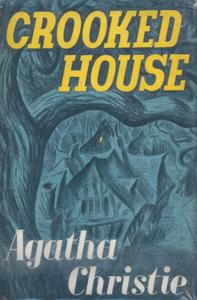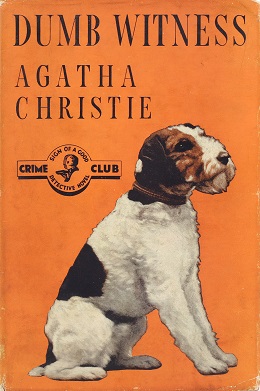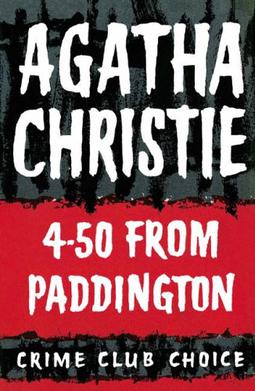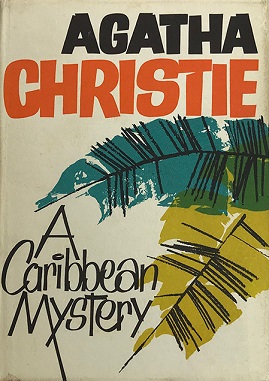
Strychnine is a highly toxic, colorless, bitter, crystalline alkaloid used as a pesticide, particularly for killing small vertebrates such as birds and rodents. Strychnine, when inhaled, swallowed, or absorbed through the eyes or mouth, causes poisoning which results in muscular convulsions and eventually death through asphyxia. While it is no longer used medicinally, it was used historically in small doses to strengthen muscle contractions, such as a heart and bowel stimulant and performance-enhancing drug. The most common source is from the seeds of the Strychnos nux-vomica tree.

Death in the Clouds is a work of detective fiction by British writer Agatha Christie, first published in the US by Dodd, Mead and Company on 10 March 1935 under the title of Death in the Air and in the UK by the Collins Crime Club in July of the same year under Christie's original title. The US edition retailed at $2.00 and the UK edition at seven shillings and sixpence (7/6). The book features the Belgian detective Hercule Poirot and Chief Inspector Japp.

The Mysterious Affair at Styles is the first detective novel by British writer Agatha Christie, introducing her fictional detective Hercule Poirot. It was written in the middle of the First World War, in 1916, and first published by John Lane in the United States in October 1920 and in the United Kingdom by The Bodley Head on 21 January 1921.

Crooked House is a work of detective fiction by Agatha Christie first published in the US by Dodd, Mead and Company in March 1949 and in the UK by the Collins Crime Club on 23 May of the same year.

Rodenticides are chemicals made and sold for the purpose of killing rodents. While commonly referred to as "rat poison", rodenticides are also used to kill mice, squirrels, woodchucks, chipmunks, porcupines, nutria, beavers, and voles. Despite the crucial roles that rodents play in nature, there are times when they need to be controlled.

Brucine, is an alkaloid closely related to strychnine, most commonly found in the Strychnos nux-vomica tree. Brucine poisoning is rare, since it is usually ingested with strychnine, and strychnine is more toxic than brucine. In synthetic chemistry, it can be used as a tool for stereospecific chemical syntheses.
These are lists of poisonings, deliberate and accidental, in chronological order by the date of death of the victim(s). They include mass poisonings, confirmed attempted poisonings, suicides, fictional poisonings and people who are known or suspected to have killed multiple people.

Curtain: Poirot's Last Case is a work of detective fiction by British writer Agatha Christie, first published in the UK by the Collins Crime Club in September 1975 and in the US by Dodd, Mead and Company later in the same year, selling for $7.95.

Three Act Tragedy is a work of detective fiction by British writer Agatha Christie, first published in the United States by Dodd, Mead and Company in 1934 under the title Murder in Three Acts and in the UK by the Collins Crime Club in January 1935 under Christie's original title. The US edition retailed at $2.00 and the UK edition at seven shillings and sixpence (7/6).

Dumb Witness is a detective fiction novel by British writer Agatha Christie, first published in the UK by the Collins Crime Club on 5 July 1937 and in the US by Dodd, Mead and Company later in the same year under the title of Poirot Loses a Client. The UK edition retailed at seven shillings and sixpence (7/6) and the US edition at $2.00.

Murder is Easy is a work of detective fiction by Agatha Christie and first published in the UK by the Collins Crime Club on 5 June 1939 and in the US by Dodd, Mead and Company in September of the same year under the title of Easy to Kill. Christie's recurring character Superintendent Battle has a cameo appearance at the end, but plays no part in either the solution of the mystery or the apprehension of the criminal. The UK edition retailed at seven shillings and sixpence (7/6) and the US edition at $2.00.

Death Comes as the End is a historical mystery novel by Agatha Christie, first published in the US by Dodd, Mead and Company in October 1944 and in the UK by the Collins Crime Club in March of the following year. The US Edition retailed at $2.00 and the UK edition at seven shillings and sixpence (7/6).

A Pocket Full of Rye is a work of detective fiction by Agatha Christie and first published in the UK by the Collins Crime Club on 9 November 1953, and in the US by Dodd, Mead & Co. the following year. The UK edition retailed at ten shillings and sixpence (10/6) and the US edition at $2.75. The book features her detective Miss Marple.

4.50 from Paddington is a detective fiction novel by Agatha Christie, first published in November 1957 in the United Kingdom by Collins Crime Club. This work was published in the United States at the same time as What Mrs. McGillicuddy Saw!, by Dodd, Mead. The novel was published in serial form before the book was released in each nation, and under different titles. The US edition retailed at $2.95.

The Pale Horse is a work of detective fiction by British writer Agatha Christie, first published in the UK by the Collins Crime Club on 6 November 1961, and in the US by Dodd, Mead and Company the following year. The UK edition retailed at fifteen shillings and the US edition at $3.75. The novel features her novelist detective Ariadne Oliver as a minor character, and reflects in tone the supernatural novels of Dennis Wheatley who was then at the height of his popularity. The Pale Horse is mentioned in Revelation 6:8, where it is ridden by Death.

A Caribbean Mystery is a work of detective fiction by British writer Agatha Christie, first published in the UK by the Collins Crime Club on 16 November 1964 and in the United States by Dodd, Mead and Company the following year. The UK edition retailed at sixteen shillings (16/-) and the US edition at $4.50. It features the detective Miss Marple.
An angel of mercy or angel of death is a type of criminal offender who is usually employed as a caregiver and intentionally harms or kills people under their care. The angel of mercy is often in a position of power and may decide the victim would be better off if they no longer suffered from whatever severe illness is plaguing them. This person then uses their knowledge to kill the victim. In some cases, as time goes on, this behavior escalates to encompass the healthy and the easily treated.
Thallium poisoning is poisoning that is due to thallium and its compounds, which are often highly toxic. Contact with skin is dangerous and adequate ventilation should be provided when melting this metal. Many thallium compounds are highly soluble in water and are readily absorbed through the skin. Exposure to them should not exceed 0.1 mg per m2 of skin in an 8 hour time-weighted average.
Christiana Edmunds, was an English murderer, popularly known as the "Chocolate Cream Killer", who carried out a series of poisonings in Brighton during the early 1870s. Edmunds purchased confectionery from a local shop and laced them with strychnine before returning them to be sold to unsuspecting members of the public. Her actions resulted in several people becoming seriously ill, and at least one death. Arrested and put on trial, Edmunds was initially sentenced to death. However, this was later commuted to life imprisonment. She spent the rest of her life at the Broadmoor Criminal Lunatic Asylum, dying there in 1907.

Gelsemine (C20H22N2O2) is an indole alkaloid isolated from flowering plants of the genus Gelsemium, a plant native to the subtropical and tropical Americas, and southeast Asia, and is a highly toxic compound that acts as a paralytic, exposure to which can result in death. It has generally potent activity as an agonist of the mammalian glycine receptor, the activation of which leads to an inhibitory postsynaptic potential in neurons following chloride ion influx, and systemically, to muscle relaxation of varying intensity and deleterious effect. Despite its danger and toxicity, recent pharmacological research has suggested that the biological activities of this compound may offer opportunities for developing treatments related to xenobiotic or diet-induced oxidative stress, and of anxiety and other conditions, with ongoing research including attempts to identify safer derivatives and analogs to make use of gelsemine's beneficial effects.
















